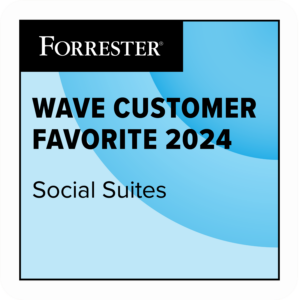Popular brand accounts on social media often have an incredibly distinct writing style and tone that cuts through the noise – and an effective social media style guide is often the source of their success.
Think of Wendy’s, a brand that has built a standout social media style and voice by talking about internet culture more than burgers. Wendy’s gets away with being sassy and irreverent, and fans love it.
To achieve that kind of fame for your brand, you need a social media style guide. From capitalization rules to fonts, a comprehensive social media style guide lays out clear guidelines for any kind of writing that appears on your brand accounts.
When codified and evangelized, these guides get anyone who touches social media marketing – from an intern to the CMO – on the same page. The result is a distinct brand voice that can cut through the clutter on social media.
What should I know before I make a social media style guide?
You and others on the marketing team have likely defined your target market and created customer profiles, also known as customer personas. If you don’t have these, you should create them before building your social media style guide. You need to know who you’re trying to reach, and creating customer personas will help you develop a brand voice and guidelines that resonate with the people you want as followers and customers.
What is a customer (or buyer) persona? In its loosest sense, it’s a collection of data about your ideal customers. It might include the following data points:
- Location
- Occupation
- Language
- Age and generation
- Economic bracket
- Interests
- Challenges or pain points
- Business goals
- Number of employees (for B2B)
- Social channels of choice
A buyer persona ties all these data points together and presents them as if they were describing a real-life person. It helps your social team speak to an ideal single person instead of a general group, which creates more compelling social content.
What goes into a social media style guide?
To maintain a signature style across platforms, you need to set, document, and socialize clear copywriting rules. But when creating your brand’s social media style guide, there’s no need to start from a blank page.
Here is a basic outline of the sections that are most essential to include.
- Language: Define the language – including dialect – your brand speaks. It should match the primary market where you operate. For example, a Mexico-based brand will use Mexican Spanish. A global brand that markets to mostly English-speaking customers can use either British or American English, depending on where the bulk of its customers are located. If your brand crosses many geographies without a unifying language, consider having brand accounts for each of the languages your primary customers speak.
- Grammar: Every post from your brand social accounts should follow the same grammar rules. These should cover things like:
- Abbreviations: Decide your brand’s rules for shortening words or using acronyms. When you post on social platforms with character limits, you’ll likely use acronyms and abbreviations in place of commonly used terms. You can shorten “search engine optimization” to SEO, for instance, and expect most of your readers to know what it means. In your guidelines, list the acronyms or abbreviations your team members might need, then specify when each form of the term may be used.
- Exclamation points: Explain when to use (or whether to avoid) exclamation points.
- Commas: As the debate over Oxford commas, also called serial commas, rages on, decide whether to use them or not and stick to that decision.
- Dates: Dates are formatted and read differently in different parts of the world. For example, 4/12 means April 12 for some places and December 4 for others. The easiest path? Spell out or abbreviate the month, rather than using numerals, when writing dates for promotions, sales, events, and so on. Decide how and whether to include days of the week and whether to abbreviate them, too (i.e., Tues.).
- Time conventions: Determine whether your audience is more familiar with the 24-hour clock or Standard Time (i.e., 16:00 vs. 4:00 p.m.) and stick with that. You also need to specify the time zone for events, such as webinars or sales meetings, so that you’re not confusing or limiting your audience. Most U.S.-based businesses use either ET or CT, while many Silicon Valley companies use PT. Determine whether and when to include time zones.
- Capitalization: For headlines and titles, you can go with Title Case Like This. Sentence case, which capitalizes only the first letter in a heading, is becoming more common online and is often used in the media. On the other hand, some brands, like Domino’s, deliberately use all lowercase in their social media to mimic the style of younger customers.

- Dashes: Although it gets a bad rap for being overused by ChatGPT and other AI platforms, the em dash has been around forever and still has its uses. Determine if you want to use em dashes, which are longer (—), or an en dash, which is a little shorter (–), and whether you want spaces around the dash or want the words to abut directly against them. For example, you can use the en dash like this – a shorter dash with spaces on either side. Or you could use this em dash—a longer one with no spaces on either side. Either way, be sure not to mistake the hyphen, the shortest of its horizontal brethren, for a dash. A hyphen should only be used to join compound words, like “user-friendly” or “sister-in-law.”Trademarks: Include a list of all your brand trademarks, both in written and image form. The trademarks should be in their correct case.
- Terminology: Your branding guidelines might also include brand-specific terminology, such as how you refer to products, services, or employees. For example, IBM calls its employees “IBMers” and Google refers to its new hires as “Nooglers.” Starbucks refers to its baristas and other crew members as “partners.” Your employees can be your best brand ambassadors on social media, and what you call them will reflect your company culture.
As you craft your unique guidelines, keep in mind that they should help your content producers share the brand message more clearly, not constrain them. Less rules is usually better than more.
How do I create a social media style guide quickly?
Want to speed up the creation of your social media style guide? Choose an existing style guide, like the Associated Press Stylebook or the Chicago Manual of Style, as a baseline for your social media style guide.
You can set your own exceptions to the rules, of course, but otherwise your team can default to the established guide. (Hot tip: Give everyone at your company who touches social media online access or a physical copy of the baseline you choose.)
To align your team further, you can also choose a respected dictionary in your chosen language and make it the dictionary of record for your brand.
Here’s an example of a simple social media style guide that uses this approach:
- Follow the Associated Press Stylebook, with the following exceptions:
- Use Oxford commas.
- Use title case, meaning Capitalize Every Word In A Heading.
- Use numerals for all numbers (i.e., “8” instead of “eight”).
- Use the Merriam-Webster dictionary for all term definitions.
However, you may not want to use an existing stylebook and instead create your own from scratch. This is a more challenging path, so only choose it if it serves your social media goals.
Do brand visuals and design rules belong in a social media style guide?
While you may have graphic designers to create your visual assets, your social team will still need to follow brand guidelines when sharing graphics and videos.
Your brand likely already has visual guidelines. If these also apply to social, there’s no need to change them for your social media style guide – you can simply reference or link to them.
If you opt to create these guidelines, here’s what to consider:
- Color palette: If you’re using an app like Canva or Photoshop to create graphics, you can program your brand colors into your templates.
- Fonts: On Instagram Stories, for example, there is a range of font choices for text. Decide which ones your brand uses and stick to them.
- Video style: Do you use filters or specialized edits? Where do you include captions and other graphic elements? While video production is its own topic, you can define a few basic rules for social video that enable your social media team to use your video assets effectively.
How do I create a comprehensive social media style guide from scratch?
You need to be process-oriented in creating your social media style guide. Consider the following steps to build and implement a style guide that makes your brand distinct on social media.
1. Audit and align your brand’s social media profiles
First, audit your company’s social media profiles. You might be surprised at how many there are. Many larger companies now use different social media channels for various purposes, such as corporate news and customer service.
In your social media audit, you’ll want to document the following:
- Every brand account on each platform, including the handle
- Login information for each account and a list of all people with access
- Brief statement of purpose, such as “customer service,” “brand marketing,” or “native shop sales”
- Number of followers and average engagement rate
- Cadence of posting (i.e. 3 times per week, once a day, etc.)
Next, take a look at your resources. Is your team stretched thin trying to post on every account? Do you have the time needed to make meaningful traction on TikTok? See where you’re getting the most engagement from your efforts and where you can consolidate or close accounts that aren’t working for your brand. This will allow you to create a style guide that addresses only the platforms you’re focused on.
2. Define your brand’s voice and tone
Marketers often interchange the terms “voice” and “tone,” but they’re actually quite different from each other.
- Brand voice is your brand’s consistent personality and character that remains stable across all communications. Think of it as your brand’s identity or DNA, and describe it as if describing a person. For example, your brand voice might be “authoritative and trustworthy” or “friendly and goofy.” Your brand voice should rarely change because it’s tied to your core brand identity.
- Brand tone is how you express your voice in different situations and contexts. It’s the emotional inflection in your voice that adapts slightly based on context, i.e., the platform you’re using, the audience, the situation, and the purpose of the communication. While your voice stays consistent, your tone flexes. Think of it like how you speak differently when consoling a friend versus celebrating a victory.
When you define your brand voice and tone, it’s a good idea to keep it simple. Try to keep each definition to just a few words.
3. Create your social media guidelines
Now that you know your brand voice and tone and have determined where to focus your social media efforts, you’re ready to create your overarching social media guidelines.
Consider these categories:
- Copywriting guidelines.
- Visual guidelines.
- Voice and tone guidelines.
- Target audience and goals.
- A list of topics you’ll cover. For example, a beauty brand might cover new product launches, pop culture, innovations in the beauty industry, and beauty trends.
- A list of topics you’ll avoid. Some brands won’t engage in political topics, while others thrive in that space. Be clear on how your brand treats global news events, political discussions, or anything that might be controversial for your target audience.
- Structural guidelines and templates. Approximately how many words should Instagram captions be, or does it depend on the topic? How many images should go in a carousel? Create templates for common types of posts (like product launches) or explain how to make these from scratch for each event.
- Instructions for finding content sources. For example, do you have a shared folder for branded assets that have been approved for social use? Is there a repository of case studies you want the social team to repurpose? Will you need to schedule regular interviews with company SMEs? Make it clear where your social team can find what they need.
- Approval and publishing process. Whether you use a social media scheduling tool or post directly, you’ll want to define the process and make approvals simple and quick. Keep in mind that if your guidelines are clear, you can trust your social team to execute. The last thing you want is to get bogged down by excessive approval requirements that put your social team behind the fast-moving online conversation.
Finally, once you’ve created your guidelines, make sure they’re accessible to everyone who needs them, and determine a cadence for revisiting and updating them.
4. Consider channel-specific formatting guidelines
Different social networks have slightly different formatting conventions, so your social media style guide should account for these. For instance, X (Twitter) has a 280-character limit, but will allow you to add tweets to a thread (and Premium accounts can post up to 25,000 characters). Instagram does not let users click on links in posts, but you can include links in Stories.
Regardless of these differences, there are some guidelines all your accounts should follow:
- Pay attention to the “hook,” whether that’s the first sentence in a text post or the first few seconds of a video. You need something compelling enough to stop the scroll.
- Shorten links using the platform’s native functionality and be sure that the preview and meta description are accurate and informative.
- Use hashtags and mentions sparingly. They should always be contextually relevant.
- Use an image that adds value to the post. For mediums like LinkedIn and X (Twitter), you don’t need an image with every post.
You can also specify what emojis your brand uses and when. Some brands will choose a few emojis as their “signature.”
5. Develop your situation response playbook
How does your brand use social media to interact with customers and competitors? If you’re not responding to customers directly on social media, you’re missing a major opportunity.
Your social media guide should have a section on how to deal with these situations. Your brand voice will significantly influence your responses. If your brand voice is “sassy,” like Wendy’s, you can get away with gently roasting your followers. But if you’re a more serious brand, that won’t fly, and can make problems worse.
Use social listening tools and automation to help respond to social media customer service mentions on social media. Your brand will have to respond to private messages, too. Even if you’ve deployed a chatbot to respond to customer inquiries, its responses should also follow your brand voice.
Finally, don’t forget to include a response plan for negative comments on social media. Even the best brands receive them from time to time, and how you respond can make the difference between losing a customer and impressing them.
Final thoughts on social media style guides
The tips and steps above will help you get started on creating your brand’s own social media style guide.
While your social media team should follow the guide closely to ensure consistency across platforms, it’s important to remember that the style guide is a living document. It should adapt to your audience’s changing preferences, social trends, and changes to social media platforms.





















